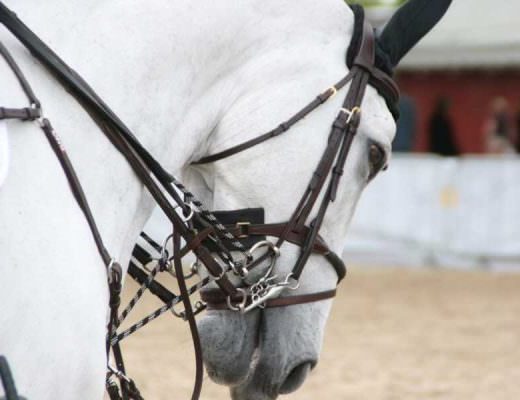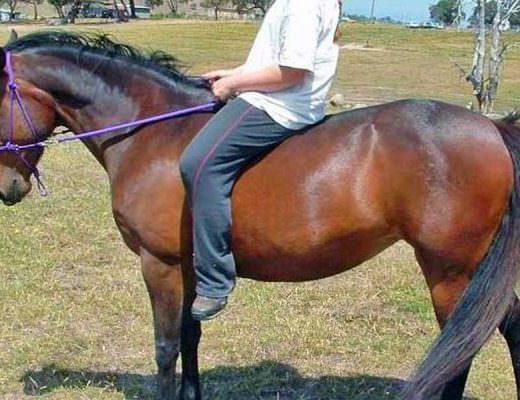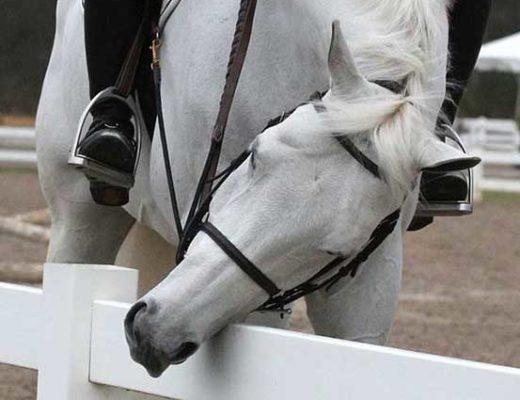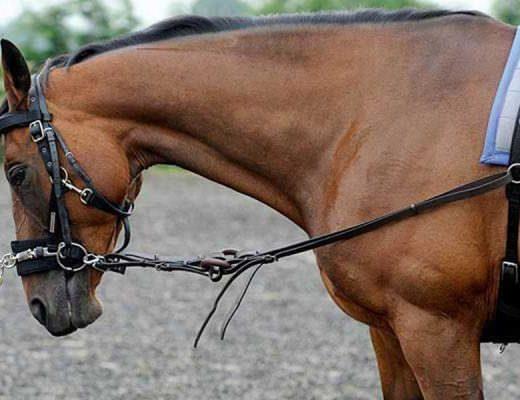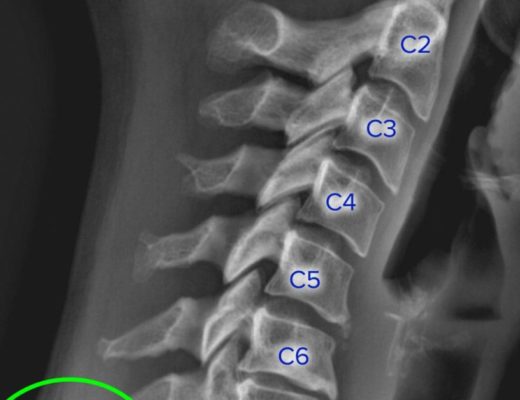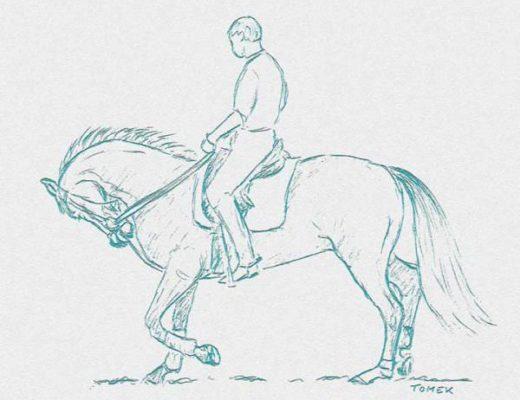All disciplines of riding can be improved through mental concentration.

The ability to tune out distractions, tune out your personal thoughts, tune out that speeding ticket you got on the drive to the barn; and tune into your horse, what you're feeling through the reins, what your body is doing in the saddle, the timing of the aids, your horse's balance and gaits and… riding.
Whew, that's a lot of “stuff” to get around!
The exercise outlined here can help train you to ‘automatically' switch on and off the flow of concentration while working with your horse, leading to better riding and training.
From Concentration: A Guide to Mental Mastery by Mouni Sadhu
The Magic Box
The Mind's First Power
Years ago I described the contents and workings of the mind as a magic box, comparing it to the nest of boxes produced by an Oriental conjuror, who spreads his carpet and lays a box in the middle of it, then takes a number of boxes out of that box, and then a number of boxes out of each of those, until the whole carpet is piled up with boxes. I compared these boxes to ideas in the mind and described how one idea contains or gives rise to innumerable others.
Now, in order to describe the nature of the contents and working of the mind, I will pick at random an advertisement in the daily newspaper. It reads as follows: “Artistic luxury home. Hillside. Magnificent trees. 6 bedrooms. 4 bathrooms…”
What does this advertisement do to me? It does very much the same as I do when I press the self-started in my car. It sets the engine going. I can then sit still in the car and let the engine tick over while I decide where to go, or I can connect it with the transmission and steering mechanism and start my journey to a definite place.
In my mind the ticking over begins: “Home” — I instinctively and almost unconsciously say to myself, and at once several memory-pictures spring up. Several! Nay, thousands of them; homes in which I have lived — in my childhood, youth, maturity and elderliness — in which I have visited, which I have looked at as I passed them by on the road, which I have seen pictured in magazines. . . And if for one fraction of a second I allow myself to dwell upon one of these homes, thousands of details arise. Perhaps it is a door that I look at. Immediately there are hundreds and hundreds of doors of various sizes — standing and pushing around and jostling one another, and seeming to call out: “Look at me! Look at me!”
I will not try to compute the number of these memory pictures in my mind, nor what future hordes of them will arise with further experience. But I will acknowledge that every slightest one can proliferate prodigiously. It reminds me of that old story of an Eastern potentate who promised a boon to one of his courtiers, who then asked for one grain of rice for the first square on the chess board, two for the second, four for the third, and so on to the last of the sixty-four squares- a boon which the monarch smilingly granted, little recking that it would bankrupt his whole kingdom, in fact all the kingdoms on the earth, and of many earths.
In my mind I find, too, homes that might have been and homes that may be in the future-rearrangements and recombinations of the part of the homes that I have seen. In this manner I can enter the realm of imagination as well as of fact, and I may even think of birds' homes and worms' homes and gnomes' homes and heavenly homes — there is almost no end to this.
But there comes an end to the process, for something inside me says: “Among all these, which do you want to possess or to contemplate?” Now arise two further powers of the mind. I find myself saying: “I like this. I do not like that,” and thereupon pushing some of the memory-pictures away out of sight and inviting others to stay. This is the love-process.
Then comes a decision: “This one I want. To this I will go. I will work for this. I will contemplate this.” Now the mere ticking-over ceases, the transmission is engaged and the steering begins.
Discovery of the Will
In the previous section I have described a mind-cycle, beginning with a coruscation or upwelling of ideas or mental pictures, continued with a desire and ending with a decision to act. We started the engine ticking over, engaged the transmission and then handled the steering wheel. This process is a full cycle, for at this point the ideas begin to flow again, but in a prescribed direction determined by the will.
Sit down quietly and comfortably, and very slowly and gently bring your attention to a particular thing and watch what happens. I will give an example. While I write this I am lying — as it happens — on my back on the grassy slopes of a Hollywood hillside garden, holding a stiff little book aloft in my left hand, and a pencil in my right. My left wrist gets tired, so I have to lower the book now and then, which is beneficial, being conducive to frequent reflective thought. On my right is a lemon tree, which gives me pleasant dappled shade from the rays of the slanting afternoon sun. On my left are two large bushes and an orange tree, backed by overtowering pines. In front at a distance I see portions of a handsome house and, in the near foreground, a fine palm tree, some thirty feet tall. Let me shut my eyes and think only of the palm.
A procession of mind-pictures begin. Here comes a palm grove in South India in a garden where I lived for many years. In the midst of that palm grove was a pond; I find myself now in thought standing on the edge of it and looking at the water-lilies there — blue lotuses. And then (of all unexpected things — I have not directed my thoughts) a blue crayon and myself sitting at a desk at school fifty-five years ago. I still watch disinterestedly, and now comes some map drawing at school — a map of India with colored coast lines. Now a part of the map — I am writing the word Hyderabad near the northwest corner (a true memory), and now the river Indus is drawn in. My thought jumps again twenty-five years: I become principal of the college at Hyderabad — talking to the students at assembly — a lecture in physics — a glass tube — glass — Venetian glass — a curio shop — an old rocking chair — a cradle — a baby — and so on.
Such is the mental process when the driver is not there. The car goes along a road, but not of my conscious present choice. I notice incidentally that I do not produce the welling-up of the images, and I do not even produce the drifting flow of thoughts but I am the director, if and when I direct them. At other times I am merely the looker-on, just as I may be the looker-on at my own blood-stream or digestive process.
Now stop thinking about me. Select your own “palm tree” — any object. Look at it, then close your eyes, and watch for yourself within your own mind the drift of mental pictures and ideas. Do this several times with different objects, then observe that you can stop the drift by stepping into the stream and directing it. To do this you have to pounce upon one of the objects in the drift. You hold it and see what you can do with it. You watch its upwellings or coruscations and you next deliberately select one of these and watch its upwellings, and thus go on directing the flow of thought.
As an illustration of this process, let me suppose that your “palm tree” of the moment is a cow. That is what has caught your mental eye, and now you hold it and watch its upwelling. Here, standing around it, together with it, are the ideas milk, calf, horns, bull, shed, field, grass, your Uncle's favorite black cow, patience, gentleness, and many, many others. Among these you deliberately select, let us say, grass, and now you allow grass to upwell, and again deliberately select. It is the power of selection that is now to be observed and learned; we will make use of the other processes further on.
From this mental experiment you will get a new sense of power, which is the power of concentration, operated by the will. You will also get a new knowledge and experience of “I”. A third gain is that you will have learned how to think, as I will explain more fully later on.
The Roads of Thought
The drift which I have so carefully described and you, I hope, have inspected in your own mind, is not a bad thing nor a disorderly one. It is the relaxed condition of the mind, and we can use it for resting when we are mentally tired. In the course of prolonged study involving mental effort we may stop awhile to rest and recuperate by simply leaning back, closing the eyes, relaxing the body — especially the neck — and quietly watching the mental drift1. It is not healthy to be thinking all the time. Thinking it intended for acquiring knowledge or applying knowledge. It is not essential to living.
That the drift is not something disorderly and without cause and system I will now show, by describing what I have called the Four Roads of Thought2.
These are sometimes called the associations of ideas, but, strictly speaking, that term would refer to the effects of Contiguity only, i.e., to remembered things, their parts and qualities and familiar contacts, and remembered thoughts about them.
It will be a case of Contiguity if, when I go out in my car this evening, I have a collision with another car at the corner of Hollywood Boulevard and Vine Street. We will assume that this is enough to give me a nervous shock or even some injury, but not enough to put me out of action. I have been in two such accidents — one in Wales and one in India — in which the cars were terribly damaged but I came out almost unhurt. These two accidents remain vividly in memory, so that any mention of the places Holywell and Devala, where they occurred, will instantaneously bring them, with many attendant details, into my mental view. At present, mention of the intersection of Hollywood and Vine does not bring up thoughts of a sickening blow and crumpled cars, but rather pictures of a large bank building and streams of pedestrians crossing at the signal of a green light and a semaphore marked “go”. But if I have a similar accident at that place I shall thenceforth have a strong association of that place and the event, so that my pedestrians and my bank will sink to the status of second and third quality associations in connection with the thought of that intersection of streets.
The strength of associations of ideas is due to (1) vivid or emphatic experience of two things in conjunction, as related above, or (2) frequent repetition in conjunction of two things which are not vivid or emphatic in experience. An example of the latter cause of association is the learning that, in French, “livre” means “book,” which the student usually achieves by repeating “livre” and “book” close together a number of times.
This forming of associations goes on not only in connection with our own experience, but also with what we have read or been told.
Before closing this piece of description of Contiguity, I must mention that we have juxtapositions in time as well as in space, in the form of familiar sequences. Thus a darkly lowering cloud leads to the expectation of rain, or in American towns, a peculiar thinking nursery tune sounding in the street presages the arrival of an ice-cream van. In this manner also the letter A recalls B rather than, say, Q or X. Such are the time Contiguities, sometimes amounting to the invariable sequence dubbed cause and effect in the material sciences.
The other Three Roads of Thought are: (2) Class Relationship, or logical inclusion; (3) Whole and Part, or concrete inclusion; and (4) Object and Quality or functional inclusion.
Suppose I am instructing a group. Several people are sitting before me and I utter the word “cow.” One person may think of a brown cow, another of a black one; myself, I am thinking of a five-legged cow which an old friend of mine saw in India and wrote about. Someone may jump from the class-concept “cow” to the bigger class-concept “animal.” Thus we see together an object and its class, and the mind passes easily along that road from one to the other. If I suddenly say “pencil” and ask you for the first word that comes up you may give me the Contiguity “hand” or “paper,” or, following this second Road of Thought, you may call out “typewriter,” having gone through its class to another member of the same class of things. If I pronounce “chair,” you might say “my mother's rocking chair,” or possibly “furniture,” or, if your Road of the moment is Contiguity, you might call out “cushion,” thinking of an experience of a cushion on a chair.
There are still two other Roads of Thought which you may follow in these cases. One is that of Analysis or concrete inclusion. This gives the relation between whole and part of an object. It may lead from “cow” to “horns,” horns being part of a cow, or from “chair” to “back” or “legs”.
Fourth, we have the Road of Quality or functional inclusion, from which may arise innumerable adjectives, such as “old” or “new,” “soft” or “hard,” “figured” or “plain,” “big” or “little,” “round” or “square,” “blue” or “green,” “quick” or “slow.” For example, “tortoise” may give rise to “slowness,” “elephant” may give rise to “strength.” To a Hindu mind, which often tends to run on abstract more than concrete lines, “cow” generally calls up “beneficence” or “bounty,” for to most of them it has stood since childhood as the chief symbol of that quality. For convenience I give a chart showing examples of the four Roads of Thought.
THE FOUR ROADS OF THOUGHT
—–
Examples:
- Milk — baby; pen — hand; ship — sea; spade — garden; fatigue — sleep; gluttony — indigestion.
- Animal — dog; view — landscape; chair — table; red — blue; heat — cold.
- Car — wheel; tree — root; house — door; root — branch; arm — leg.
- Earth — round; coin — silver; ice — cold; ink — fluid; lemon — yellow.
Some readers may say that all this sounds rather theoretical and technical. Let me assure them that I have not mentioned these Roads except for the purpose of using them in concentration exercises. Even so, it is quite possible to put the matter in a more general and for some an easier way by saying that there is always a reason for the association of ideas — that if one mental picture gives rise to hundreds of others there will be a precise reason for every one of them, and no mere chance at all in the process.
Thus, if someone asks why he thinks of milk when he hears the word cat, the reason is that this conjunction is a matter of familiar experience. If he thinks of claws, or whiskers, that is because claws and whiskers are part of the cat.
Knowledge of the Roads is valuable for working in a very precise way and getting all you can out of “cat.”
The Practice of Recall
We may now turn to the first exercise:
Exercise 1.
Study the following diagram:
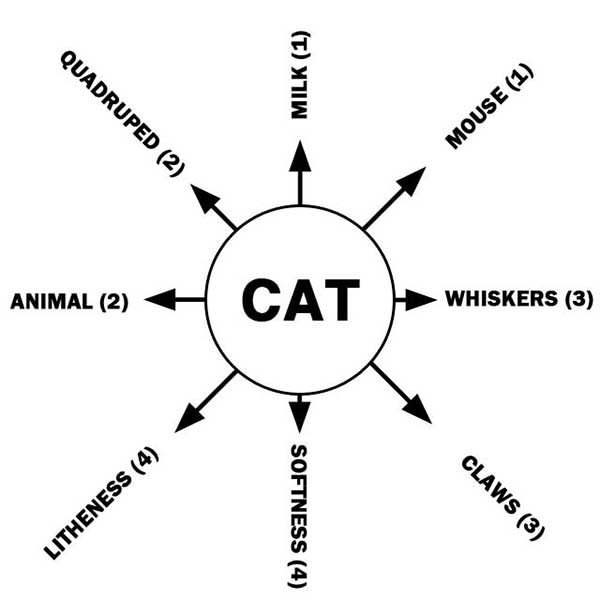
Copy it on a large sheet of paper and try to increase the number of arrows to 100. Write in a Road-nomination or reason for each arrow-word, in the manner shown in number-brackets on the diagram. If you cannot put in 100 at one sitting, keep the diagram and continue the work each day. If you dislike cats, use “dog” or anything else, for it is a rule of mental health not to ponder on disliked things. Do this exercise every day for a week, at least.
Take care not to think about the milk, or mouse, or whiskers, etc. Merely notice them and write them down and then slide your attention back along the arrow to the cat. Do not jump back, but slide back. Then ask yourself, “What next?” while looking at the cat. Again write down any idea that comes up. When you have written down a good many, you may find the mind going empty, and bringing out no more. Still hold on for a while, and only after a little while more begin to use the Four Roads systematically to find some more.
When at last you do decide to give up waiting or looking for more arrow-words, you may stop and think about what you have been doing. You have been doing concentration, practicing return, and getting to know what it feels like. Incidentally, you have also been tidying up some of the contents of your mind.
Exercise 2.
Now decide to concentrate mentally on a cat (or other object) for five minutes. Look at the clock and make a note of the time. Tell yourself that you are going to keep the cat idea in mental focus for five minutes. Don't think about the time, but make a note of it. After a while you will suddenly realize that you are thinking of something else — note the time — and have forgotten the cat in the meantime. Try to find the cause of this. Was it due to a drift beginning with milk, mouse, whiskers or any other of the hundred direct associations standing around the cat? Was it due to the intrusion into the mind of bodily discomfort, disturbed breathing, sense receptions through hearing, sight, smell or touch? Was it due to a thought of failure in your experiment, or to wondering-if-you-can, or anxiety about something , hurt pride, anger, fear, discontent, timidity, worry or anything of this kind? Do this exercise every day for at least a week, and observe the increase of the period of concentration.
Exercise 3.
Most important. Do this one every day for a month.
Concentrate as before on a cat, or some other pleasing object. Do not try to think only of the cat, but deliberately send your thought out along the arrows one after another with the instruction to look there and return to the center. Say “milk–cat, mouse–cat, whiskers–cat, claws–cat” and all the rest of your arrows, and then more. Bring into vision everything you can think of that has a direct connection with “cat” by all the four Roads of Thought. When you cannot think of any more still try hard to think of other things without letting the cat fade from the focus of your attention. Hold onto the cat while you try to penetrate the void. Say to yourself, “Is there anything more on Road 1, on Road 2, on Road 3, on Road 4?”
Explanation. In this exercise you are controlling your thoughts or ideas with your will. Slowly your will establishes a habit of recall which operates under a mood of concentration. After you have practiced this exercise every day for a month you ought to be able to put on this mood — which is a feeling — on the slightest decision of the will, silently saying, “Now, concentration.”
I can give a very good simile for this to all who know how to swim. When going for a swim you arrive at the edge of the pool, and say to yourself, “Now, swimming.” “Do I?” you will ask, perhaps with a little surprise, “I never noticed it.” No, you did not notice it, but you do say to yourself, “Now, swimming,” and instantly a change comes over the body — and you can swim. Even if you are the best of swimmers and you fall into water accidentally, you flounder about like a beginner in the art of swimming until you recover yourself and realize, “Why! I am in the water,” and then you almost subconsciously say, “Now, swimming.”
It is not different even when walking. We get up and say, “Now, walking.” Then we walk, and all the muscles concerned do their work. Psychiatrists will confirm my statement that there are many people not walking this earth but lying in bed or going about in wheelchairs merely because they have a mind-inhibition which prevents them from saying to themselves, “Now, walking.”
When I start teaching this method of recall there is nearly always someone who asks: “But it is not sufficient merely to try to concentrate on something and keep on persistently bringing the mind back to that thing whenever it wanders away from it?”
The answer is “No.” In all these matters we must do no violence to body or mind. We are not hard and lofty masters whipping a wild animal into sullen obedience. We are philosophers — people who know how to live. We know that happiness of body and mind consists in their functioning in a manner and degree harmoniously as one, relating us with understanding and all-over purpose to events and our fellow beings and the wellspring of divine purpose that brings order and joy from the within of our lives, is best. Thus our lives will blossom like the rose, whose beauty and fragrance come from its secret depths — which does not battle for power, which cannot be chiseled or hammered into shape, yet fulfills itself in yielding its best to its order of society, its own circle of living beings. Truly can it be said of such a life that it tells us of fulfillment, harmony, happiness and faith, and in its gracious yielding to the order of its being there is a spiritual consummation — “the dewdrop slips into the shining sea” while “the universe grows I.”
I have not gone far afield and forgotten our present study. That mind of ours is to be like the rose, which surrenders itself to no violence, nor proposes to do it to another.
Let me take up another simile for this practical job of learning concentration. You are sitting reading and you have your dog lying beside you. The dog becomes restless. You call out, “Fido, come here, lie down.” Fido obeys, but very soon, when you are not looking, he is away again. You call him, and the process is repeated again and again. Similarly, bringing the mind back again and again to the object of concentration teaches it to concentrate under the stern eye of the will, but not to unfold its own power naturally in more harmoniously living. It does not produce the mood of concentration and the habit of recall which functions within that mood. There is all the difference in the world between the obedience of a slave (called tamasic) and the ordered activity of intelligent cooperation and mental fruitfulness seen in an ideal family (called sattvic).
I have prescribed a whole month for this exercise. By that time the average reader of this book should be able to give his attention to one thing in tranquil concentration for any reasonable length of time. This will then lead to a great many other things.
1 I want to warn some readers against the habit of mental relaxation into ideas of sensuous experience, which is not uncommon. Some people do this to induce sleep. Looking at the mental drift, if continued, will induce sleep also, and it is a much better way. It induces sleep with full mental relaxation and does not conduce to dreams.
2 For the full exposition of the Four Roads of Thought, including the subdivisions of them, making nine in all, see Mind and Memory Training by Ernest Wood, published by Sir Isaac Pitman and Sons, Ltd., London, England. However, that full exposition is not required for the practice of concentration, though necessary in memory training.

